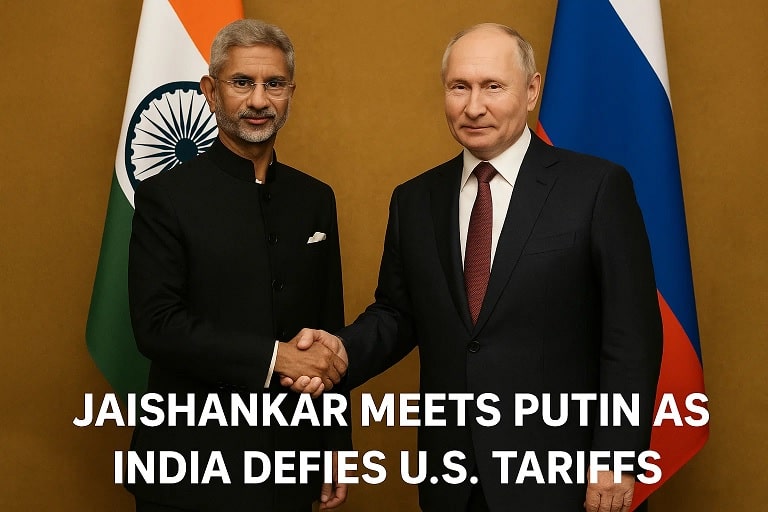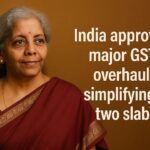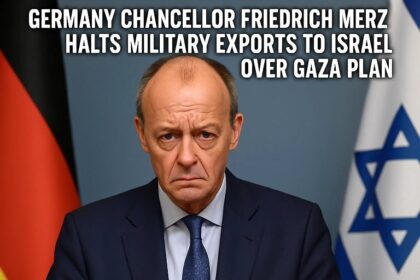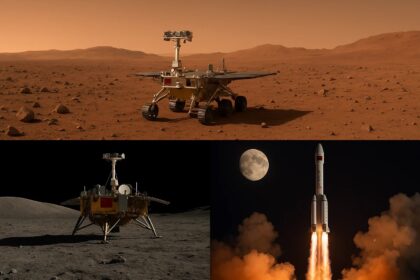Jaishankar Meets Putin as India Defies U.S. Tariffs: A Bold Assertion of Strategic Autonomy
On August 21, 2025, India’s External Affairs Minister S. Jaishankar met Russian President Vladimir Putin in Moscow, reinforcing India’s commitment to deepening ties with Russia amid escalating trade tensions with the United States. The meeting, part of Jaishankar’s three-day visit (August 19–21), occurred against the backdrop of U.S. President Donald Trump’s imposition of 50% tariffs on Indian goods, including a 25% penalty for India’s continued purchase of Russian oil. Jaishankar’s discussions with Putin and Russian Foreign Minister Sergey Lavrov emphasized expanding bilateral trade, addressing the trade deficit, and advancing connectivity projects, signaling India’s defiance of U.S. pressure and its pursuit of strategic autonomy. This article provides a detailed analysis of the visit, its geopolitical context, implications, and supporting data in tables, concluding with answers to frequently asked questions.
Overview of Jaishankar’s Moscow Visit
Jaishankar’s visit included co-chairing the 26th India-Russia Inter-Governmental Commission on Trade, Economic, Scientific, Technological, and Cultural Cooperation (IRIGC-TEC) with Russian First Deputy Prime Minister Denis Manturov, addressing the India-Russia Business Forum, and holding strategic talks with Lavrov and Putin. The discussions focused on:
Trade Expansion: Addressing the $59 billion trade deficit, with India-Russia trade surging to $68 billion in 2024-25, largely due to Russian oil imports.
Connectivity Projects: Advancing the International North-South Transport Corridor, Chennai-Vladivostok maritime route, and Northern Sea Route.
Defense and Energy: Strengthening military-technical cooperation and securing long-term fertilizer and oil supplies.
U.S. Tariffs: Jaishankar questioned the logic of U.S. tariffs, arguing India’s oil purchases stabilize global energy markets.
The visit followed Prime Minister Narendra Modi’s phone call with Putin and National Security Advisor Ajit Doval’s Kremlin meeting on August 7, 2025, underscoring India’s proactive engagement with Russia amid U.S. sanctions and tariffs. Putin confirmed plans to visit India for the annual India-Russia Summit later in 2025, highlighting the “special strategic partnership.”
Historical Context: India’s Balancing Act
India has maintained a robust relationship with Russia since the Cold War, with defense and energy as cornerstones. Since Russia’s 2022 invasion of Ukraine, India has ramped up Russian oil imports, rising from 2% to 20% of its crude supply, making it Russia’s second-largest oil buyer after China. This shift, driven by discounted prices, saved India $7 billion in 2024 but drew U.S. criticism for indirectly funding Russia’s war. Trump’s tariffs, announced on August 6, 2025, impose a 25% base rate plus a 25% penalty, effective in two phases (August 7 and August 27), totaling 50%—among the highest on any U.S. trading partner.
India’s defiance reflects its multipolar foreign policy, balancing ties with Russia, China, and the West. Jaishankar’s earlier meeting with Chinese Foreign Minister Wang Yi and Modi’s praise for Putin as a “friend” signal India’s resistance to U.S. pressure, especially as China faces lower tariffs (15–20%) despite being Russia’s top oil buyer. The tariffs have strained India-U.S. relations, with India pausing defense procurement talks and condemning the measures as “unfair, unjustified, and unreasonable.”
Detailed Breakdown of the Visit
Key Meetings
Putin Meeting (August 21): Jaishankar conveyed greetings from President Droupadi Murmu and PM Modi, discussing trade, defense, and preparations for Putin’s India visit.
Lavrov Talks: Focused on removing non-tariff barriers, boosting Indian exports (agriculture, pharmaceuticals, textiles), and reviewing BRICS and SCO cooperation.
IRIGC-TEC with Manturov: Covered energy, infrastructure, and joint ventures under India’s ‘Make in India’ initiative, with a focus on correcting the trade imbalance.
Trade and Economic Focus
Trade Surge: India-Russia trade grew from $13 billion in 2021 to $68 billion in 2024-25, a 700% increase, driven by oil imports.
Trade Deficit: India’s deficit ballooned from $6.6 billion to $59 billion, prompting calls for diversified exports.
FTA Progress: Signed Terms of Reference for an India-Eurasian Economic Union Free Trade Agreement to boost trade balance.
Business Engagement: Jaishankar urged Russian firms to invest in India’s $4 trillion economy, citing opportunities in IT, construction, and engineering.
Connectivity and Cooperation
Corridors: Plans to expand the North-South Corridor, Chennai-Vladivostok route, and Northern Sea Route to reduce transit times and enhance trade.
Energy and Defense: Long-term fertilizer supplies, nuclear energy collaboration, and joint defense production were prioritized.
Skilling and Mobility: Initiatives to address Russia’s labor shortages with Indian professionals.
U.S. Tariff Context
Tariff Details: 25% base tariff (effective August 7) plus 25% penalty (effective August 27) for Russian oil purchases.
India’s Response: Jaishankar argued India’s oil imports stabilize global markets, a view once supported by the U.S.
Double Standards: Critics note the U.S. imports Russian uranium and fertilizers, and China faces lower tariffs despite larger oil purchases.
In-Depth Analysis: Trends and Implications
Strategic Implications
Jaishankar’s visit underscores India’s strategic autonomy, resisting U.S. pressure while strengthening ties with Russia. The tariffs, intended to curb Russia’s war funding, have instead pushed India closer to Moscow and Beijing, as seen in Modi’s recent China engagement. The White House claims the tariffs influenced Putin’s willingness to discuss Ukraine peace, but Russia dismissed this as “speculative.” India’s stance aligns with its BRICS and SCO roles, advocating a multipolar world order.
Economic Impacts
Trade Growth: The tariff row may accelerate India-Russia trade, with Russia offering a welcoming market for Indian exports.
Market Reaction: India’s Nifty 50 and BSE Sensex fell 0.95% on August 9, reflecting trade uncertainty.
Consumer Impact: Higher tariffs could raise costs for Indian exporters, potentially increasing domestic prices if trade isn’t rerouted.
Geopolitical Trends
India-Russia Bond: Described as the “steadiest” post-WWII relationship, with energy and defense as pillars.
U.S.-India Strain: The tariffs and paused defense talks signal a cooling of ties, despite India’s role in U.S. Indo-Pacific strategies.
China Factor: India’s warming ties with China, including border peace talks, complicate U.S. leverage.
Challenges
Trade Imbalance: India must boost exports to Russia to reduce the $59 billion deficit.
U.S. Retaliation: Further tariff escalations or sanctions could strain India’s economy, reliant on U.S. trade ($120 billion annually).
Geopolitical Risks: India’s balancing act risks alienating Western allies while navigating Russia’s Ukraine conflict.
Future Projections
Putin’s planned India visit by late 2025 could yield new trade and defense agreements. India may redirect exports to Russia and BRICS nations to offset U.S. tariffs, potentially increasing bilateral trade to $100 billion by 2027. However, sustained U.S. pressure or failure to resolve the trade deficit could challenge India’s strategy. The FTA with the Eurasian Economic Union could be a game-changer if finalized by 2026.
Table: India-Russia Trade Snapshot (2024-25)
Metric | Value | Details |
|---|---|---|
Total Trade | $68B | Up from $13B in 2021, 700% growth |
Trade Deficit | $59B | Up from $6.6B in 2021, driven by oil imports |
Oil Imports | 20% | India’s crude supply from Russia, second to China |
Key Sectors | Energy, Defense | Oil, fertilizers, military cooperation |
FTA Progress | ToR Signed | India-Eurasian Economic Union agreement |
Table: U.S. Tariffs on India (2025)
Tariff Type | Rate | Effective Date | Reason |
|---|---|---|---|
Base Tariff | 25% | August 7, 2025 | Reciprocal trade measures |
Penalty Tariff | 25% | August 27, 2025 | Russian oil purchases |
Total Tariff | 50% | Combined impact | Highest among U.S. trading partners |
FAQs
Why did Jaishankar meet Putin in Moscow?
Jaishankar met Putin to strengthen India-Russia ties, discuss trade expansion, and prepare for Putin’s India visit, amid U.S. tariffs on Indian goods.
What are the U.S. tariffs on India?
The U.S. imposed a 25% base tariff and a 25% penalty (total 50%) on Indian goods, effective August 7 and 27, 2025, for India’s Russian oil purchases.
How has India responded to the tariffs?
India condemned the tariffs as “unfair, unjustified, and unreasonable,” vowing to protect its economic sovereignty and boosting Russia ties.
What is the India-Russia trade deficit?
India’s trade deficit with Russia is $59 billion, up from $6.6 billion in 2021, due to heavy oil imports.
Why does India continue buying Russian oil?
India’s oil imports stabilize global energy markets, save $7 billion annually, and support its $4 trillion economy.
What sectors were discussed in Moscow?
Trade, defense, energy, agriculture, pharmaceuticals, textiles, and connectivity projects like the North-South Corridor.
How do the tariffs affect India-U.S. relations?
The tariffs have strained ties, with India pausing defense procurement talks and criticizing U.S. double standards.
What is the significance of Putin’s India visit?
The visit, planned for late 2025, will advance trade, defense, and strategic cooperation at the annual India-Russia Summit.
How does India balance Russia and U.S. ties?
India pursues strategic autonomy, strengthening Russia and China ties while engaging the U.S., advocating a multipolar world.
What are the risks of India’s defiance?
Potential economic strain from tariffs, reduced U.S. market access, and geopolitical tensions with Western allies.












